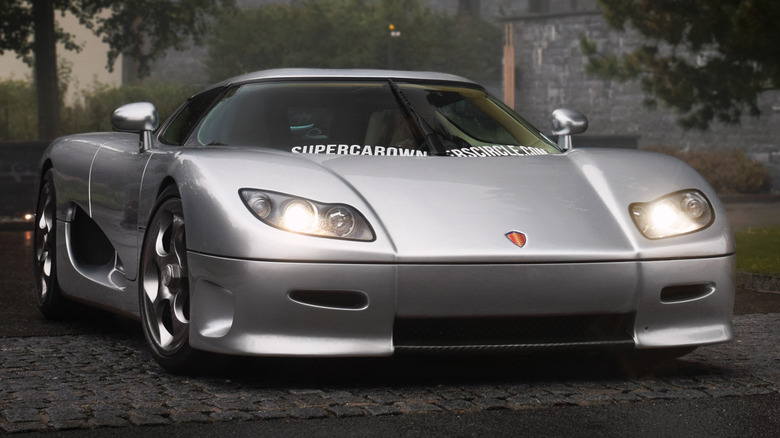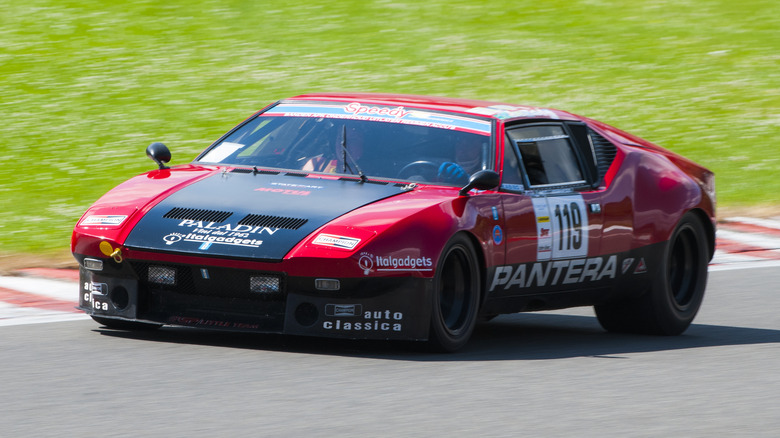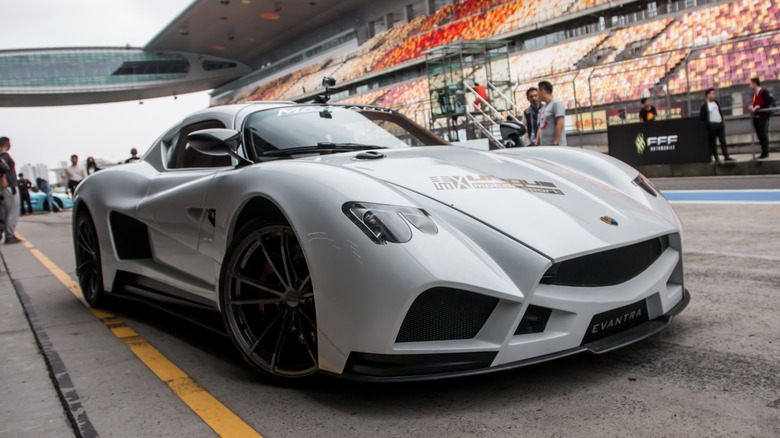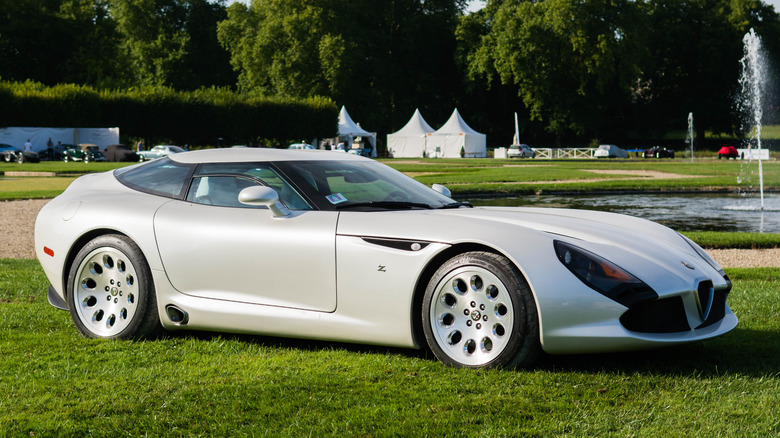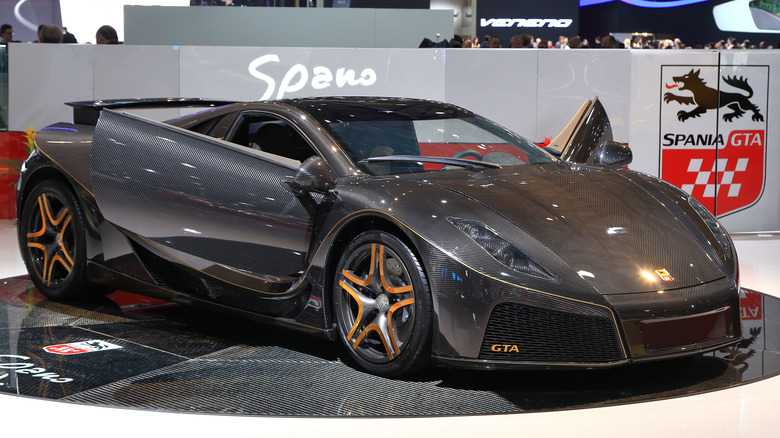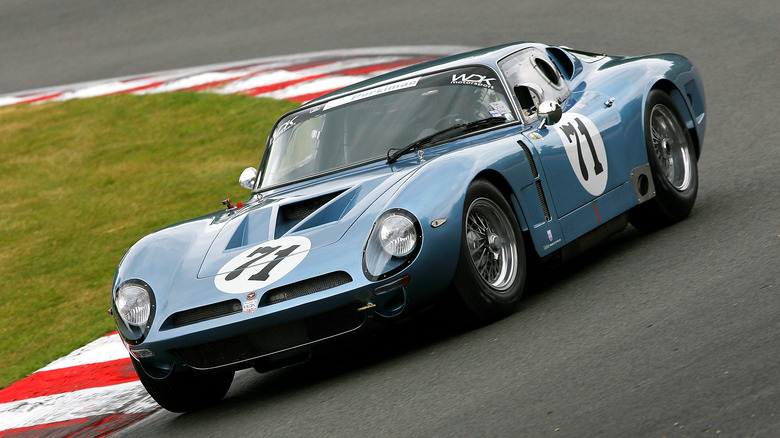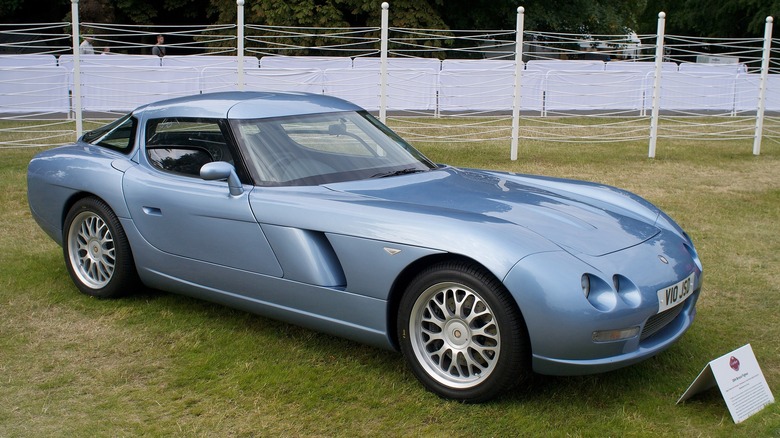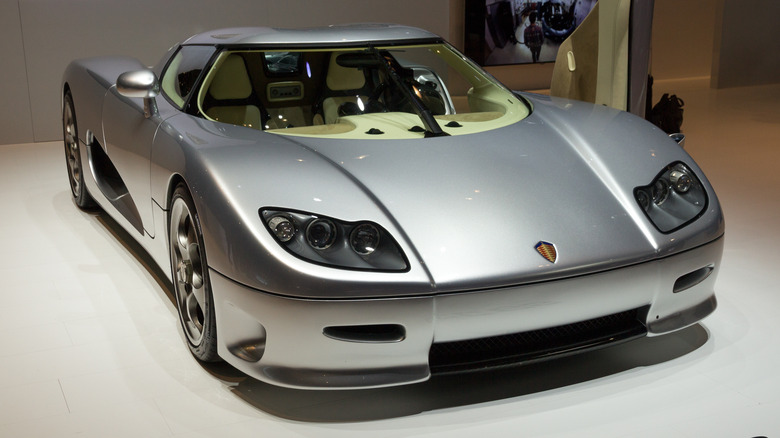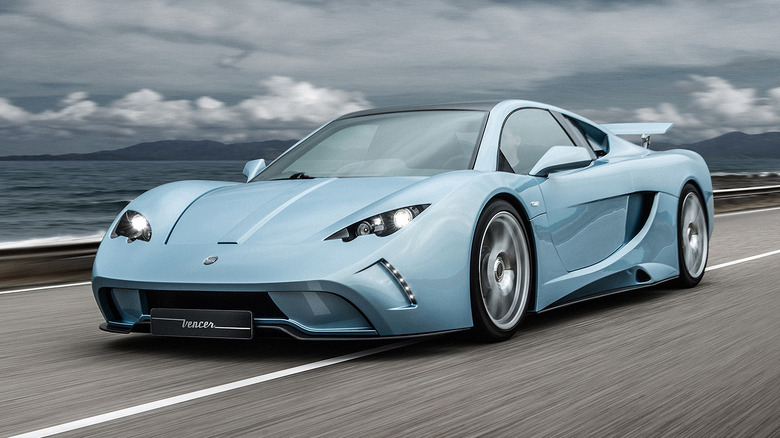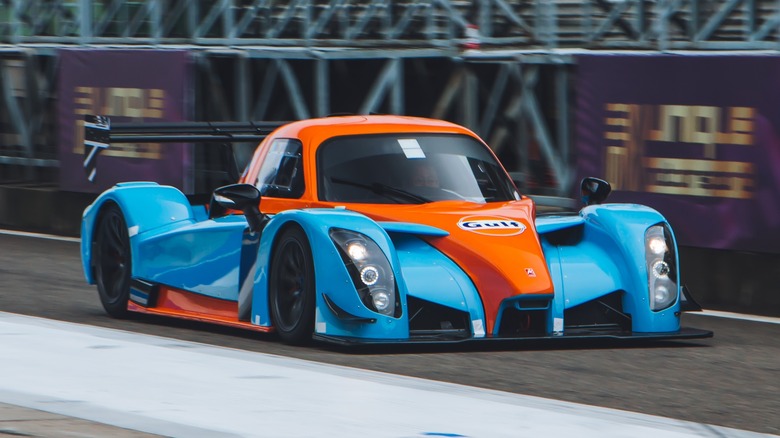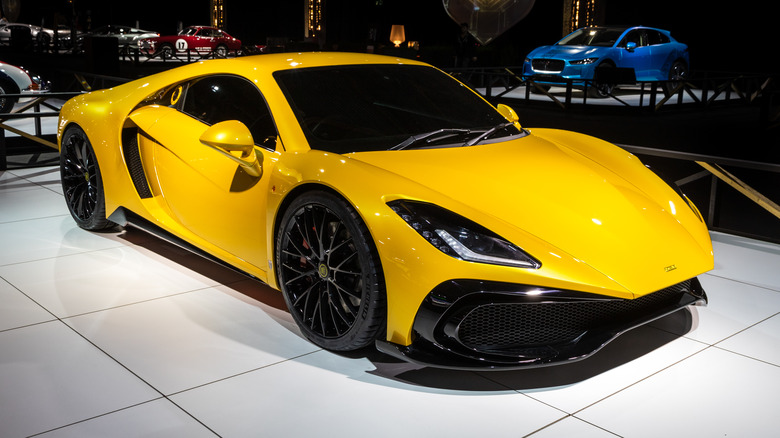10 Of The Coolest European Supercars With American Engines
The idea of combining European design and engineering with American power is far from a new one — the Shelby Cobra was doing exactly that back in the '60s. Still, the combination of many American engines' affordability, reliability, and high tunability has kept small carmakers returning to them over the decades. Some carmakers prefer adding a unique twist, modifying such engines with design tweaks and upgraded parts, while others prefer keeping things mostly off-the-shelf. Either way, the list of both classic and modern European supercars with brawny American hearts is a surprisingly long one.
The Shelby Cobra might have popularized the formula with its powerful V8. Still, in more recent years, both V6 and V10 powerplants have been popular options for boutique carmakers looking for high-power outputs. Ford, GM, and Dodge have all lent their engines to various European exotics over the years, with these 10 supercars standing out as particularly cool examples of the trend.
DeTomaso Pantera
Alejandro De Tomaso founded his eponymous company in 1959 in Modena, Italy, initially focusing on building race cars. These early cars were successful and subsequently attracted the attention of one Carroll Shelby, who contracted DeTomaso to build a new sports car for Can-Am racing. Shelby was looking for a successor to his Cobra race car, which famously combined a lightweight British sports car chassis and a powerful Ford V8 engine. Ultimately, the De Tomaso/Shelby project collapsed after just one prototype was built, but it paved the way for De Tomaso to launch his own supercar with a similar formula.
De Tomaso's first V8-engined road car was the Mangusta, but it was the Mangusta's successor, the Pantera, that would prove to be the most successful. Sold in America through a partnership with Ford, the Pantera was driven by a host of famous faces, including Elvis Presley, who once shot his car when it refused to start. Reliability was a consistent issue for early Panteras, and electrical and rust issues were common.
Despite its flaws, the Pantera enjoyed a remarkably long production run, commencing in 1970 and ending in 1993. The deal with Ford only lasted until 1975, and after that point, most Panteras were sold in Europe rather than America. However, they all still featured a Ford V8, a Cleveland in early cars, with later examples switching to a Windsor. Power outputs varied by year and territory, with the most powerful examples producing nearly 400 horsepower.
Mazzanti Evantra
While a handful of European supercar startups manage to break out into the mainstream — Koenigsegg and Pagani are two recent success stories — many more remain forever under the radar. Mazzanti Automobili is one such overlooked brand, even though it's been making cars at its factory in Pontedera, Italy for over two decades. Its flagship model is the Evantra, which features a mid-mounted LS V8 engine and, in its most potent form, it makes 1,000 horsepower. To reach that figure, Mazzanti bores out the engine to 7.2 liters and adds beefy twin turbochargers.
The 1,000 horsepower Evantra Millecavalli boasts a claimed top speed of 250 mph, and a 0-60 mph time of 2.7 seconds. The Evantra has been produced in various forms since 2013, with only a handful of examples built every year. Unfortunately, it seems that few, if any, more examples will be made, as Mazzanti is currently suffering serious financial woes. Company founder Luca Mazzanti departed the firm in 2022, with production of the Evantra halting shortly after. A group of investors have unveiled plans to buy out the carmaker, but there's no word yet on what that means for the future of the Evantra.
Alfa Romeo TZ3 Stradale Zagato
Built to commemorate Alfa Romeo's 100th anniversary, the TZ3 Stradale Zagato might look like an all-Italian exotic, but it's nothing of the sort underneath. The car is based on the chassis of a Dodge Viper ACR, and borrows the Viper's 600 horsepower V10 engine. Only nine examples of the Alfa were built, each reportedly costing over $1 million apiece. Its styling was inspired by the classic Alfa Romeo TZ racers of the '60s, which competed against the likes of the Ferrari 250 GTO in races around Europe and beyond.
The TZ3 Stradale was designed by Norihiko Harada at Zagato, with both its interior and exterior being completely bespoke. However, it's mechanically so similar to the Viper ACR that the seven-figure Italian exotic even shipped with original Viper owners' manuals. The unveiling of the most American Alfa Romeo ever made polarized collectors, even if few could argue with its head-turning looks. One example appeared for sale at RM Sotheby's in 2020, sporting just 201 miles on the clock. It sold for less than half of its original asking price, putting its depreciation somewhere around $2,500 per mile. That's a pretty extreme figure, even by Italian supercar standards.
[Featured image by El.guy08_11 via Wikimedia Commons | Cropped and scaled | CC0 1.0]
Spania GTA Spano
Spain isn't exactly well known for its supercar industry, but there have been a handful of startups launched in the country over the decades. One such small carmaker is Spania GTA, which first unveiled its Spano supercar in 2009. An overhauled second generation of the car appeared at the Geneva Motor Show in 2015, sporting design tweaks and cutting-edge graphene componentry. The Spano was reportedly the first time graphene had been used on a production car, but despite its high-tech construction, its powerplant was a little less pioneering.
The car used a modified version of the Dodge Viper's V10 engine, with some examples packing twin turbochargers. Along with a list of other performance tweaks, that made the most powerful iteration of the car good for 900 horsepower. Originally, a production run of 99 units was planned, but significantly fewer examples were eventually sold.
Exact numbers are hard to verify, but a now-archived RM Sotheby's listing for a second-generation Spano claims that 12 examples of the car have been built in total. Of those 12, 10 are first-generation cars, with just two being second gen cars. Three of the original 12 cars were destroyed during homologation testing, leaving the remaining number of production examples in the single digits. It's claimed that Singapore was the Spano's biggest market, with four examples sold, while two examples went to Chinese buyers. The Sotheby's example was originally valued between €330,000 and €450,000, but was withdrawn before the auction took place.
Bizzarrini 5300 GT
Bizzarrini is another name that plenty of enthusiasts might have never heard of, but the short-lived marque was responsible for producing some of the best Italian race cars of the '60s. Its founder, Giotto Bizzarrini, had been responsible for developing several Ferrari's most iconic classics, including the 250 GTO and 250 SWB. After a fallout with Enzo Ferrari in 1961, he was fired, and subsequently worked as a contractor over the following years. Bizzarrini designed the original Lamborghini V12 engine — evolutions of which were used in the brand's flagships up until 2010 — and helped develop the Iso Grifo.
However, after another disagreement, Bizzarrini left Iso and founded his own brand. The 5300 GT was based on his Grifo A3C design and, like the Grifo, it featured a 327 Chevy V8 engine under the hood. It produced over 360 horsepower and, combined with the aerodynamic, Giorgetto Giugiaro-designed bodyshell, made the 5300 GT a fierce contender both on the road and on the track.
Unfortunately, like many small carmakers, Bizzarrini struggled with cash flow issues and was forced to declare bankruptcy in 1969, less than half a decade after its founding. Giotto Bizzarrini tried to relaunch the brand over the following decades, but was largely unsuccessful. However, in 2020, a new group of investors bought the brand and produced a limited run of 5300 GT continuation cars, complete with period-correct Chevy V8 engines.
Bristol Fighter
Bristol Cars was originally formed as an offshoot of a British aircraft manufacturer in the postwar years. Throughout the '50s, it was considered one of the country's most prestigious brands, rivaling the likes of Bentley and Aston Martin. Over the following decades, Bristol remained a niche automaker, catering to a small group of dedicated customers, who were mostly wealthy British business owners. By the late 1990s, its client base had dwindled, and so a fresh model was needed to draw new customers into the brand's flagship London showroom.
The new model was christened the Fighter, and featured a modern, streamlined body that was significantly different to Bristol's previous old-school cars. It was first unveiled in 1999, but it would take until 2004 before any customer orders were taken. As a small, independent carmaker, Bristol didn't have the funds to develop a unique engine, and so borrowed the 8.0-liter V10 engine from the Dodge Viper. In standard form, it produced 525 horsepower and gave the car a top speed.
The exact number of Fighters produced is unclear: at least nine examples are confirmed to be registered in the UK, although it's been reported that more than double that figure were produced. This is further complicated by the fact that several Fighters were left incomplete when the company collapsed in 2020, with some remaining partially finished today.
[Featured image by Edvvc via Wikimedia Commons | Cropped and scaled | CC BY 2.0]
Koenigsegg CC8S
The very first production car from Sweden's most innovative carmaker was the CC8S, which debuted in 2000. Although its power was a long way short of the modern Koenigsegg Gemera's four-figure horsepower outputs, the CC8S was still one of the most potent supercars of its day. It produced 655 horsepower from its extensively modified 4.7-liter Ford Modular V8. The stock mill can be found in several best-selling (and much less exotic) Ford models, including the F-150, Crown Victoria, and Explorer.
To achieve supercar-worthy power output without compromising reliability, Koenigsegg overhauled almost every single aspect of the engine. Forged pistons and connecting rods were milled, dry sump lubrication was fitted, plus a new air intake, supercharger, and much more. The result was a car able to reach a top speed of 240 mph, and complete a standing quarter mile in ten seconds. Koenigsegg's first production model is also one of its rarest, with only six examples made between 2002 and 2003. A new and improved version of the car, the CCR, debuted in 2004, with further engine revisions that pushed its power output up to 806 horsepower.
Vencer Sarthe
Dutch supercar startup Vencer was founded in 2011 by entrepreneur Robert Cobben, with its first production car, the Sarthe, launched in 2014. It received generally positive reviews from the motoring press at launch, with testers praising its sharp handling and powerful engine. That engine was a GM LS3 V8, bored out and modified by Hennessey to produce more than 600 horsepower. Its top speed was claimed to be more than 200 mph with its 0-60 mph time sitting in the mid-three second range; true Ferrari-rivaling numbers, albeit with a price tag to match. This would turn out to be a sticking point.
With a launch price of around €270,000 (around $358,000 at the time), the Sarthe was even costlier than supercar rivals from the likes of the Prancing Horse and Lamborghini. Plus, it came from a Dutch startup with precisely zero track record of making supercars, founded by a man who previously owned a plumbing business.
The launch car, pictured above, was sold to a buyer in China, but Vencer struggled to find any more takers for its LS-engined supercar. By the time the startup abandoned the lease on its factory in 2016, just two examples of the car had reportedly been sold. Vencer still appears to be active as a company, but its founder has launched multiple new business ventures in recent years according to his LinkedIn profile. So, it seems unlikely that any further examples of the car will be built anytime soon.
Radical RXC
The term "race car for the road" is used liberally throughout the auto industry, but few cars encapsulate the phrase as well as the Radical RXC. First launched around a decade ago, the RXC serves as the flagship model in the British automaker's range, and borrows its styling from Le Mans prototype racers. It boasts a low-slung body, a huge rear wing, and a stripped-back, race car interior for maximum weight savings.
Early examples of the RXC sported a 3.7L Ford V6, modified by Radical to produce up to 380 horsepower. Combine that with its sub-2,000-pound curb weight, and you've got a car that's capable of cracking 60 mph from a standstill in 2.8 seconds. Later examples are even more extreme, packing a twin-turbocharged 3.5L Ford V6 that churns out up to 650 horsepower.
The RXC is a pure-bred track car, with a fully adjustable roll cage as standard and even a pit lane limiter. However, it still qualifies for a license plate, and so can be driven home after a long day of hunting apexes at the track.
Noble M500
Another British automaker enlisting Ford's 3.5-liter twin-turbo V6 engine for its supercars is Noble, which unveiled its latest creation, the M500, in 2018. After several years of development work, hampered by the pandemic, a finished pre-production car was unveiled in late 2023. Unlike many supercar makers that proudly tout the significant changes they've made to their engines, Noble has remained content to only fit minimal upgrades to its Ford V6. A new ECU ups the power output to just over 500 horsepower, but other than that, this is the same engine that's also found in the F-150 Raptor.
The key difference is that the car the engine powers is significantly lighter than a Raptor. This means each of those horses goes a lot further, although Noble has remained tight-lipped on exact acceleration figures for now. Also yet to be confirmed is the car's exact price – a reported £150,000-200,000 cost is mooted, roughly $190,000-$255,000 at current exchange rates. There's no word yet on whether the M500 will be brought Stateside, but let's hope so.
